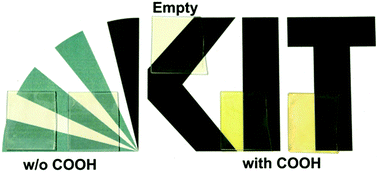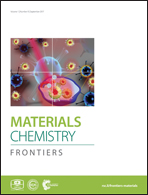Facile loading of thin-film surface-anchored metal-organic frameworks with Lewis-base guest molecules†
Abstract
In this work, we demonstrate how dye molecules with lone electron pairs, Lewis-base functionality, can be loaded into a surface anchored metal-organic framework system (SURMOF-2) directly from ethanolic solution without the need for any activation procedure. The dye loading profile throughout the SURMOF-2 layer is confirmed by time-of-flight secondary ion mass spectrometry (ToF-SIMS). The loaded porphyrin dyes show signs of aggregation, characterized by broadening of the absorption spectra and changes in the emission spectra and lifetimes. The triplet exciton dynamics of the Pd and Pt metallated porphyrin after inclusion in the SURMOF are characterized by a red-shifted phosphorescence (around 800 nm peak) with a lifetime in the range of 50 μs. The monomer-like emission (620 nm) has a lifetime of less than 3 μs. Similarly, the singlet dynamics of the Zn metallated porphyrin show no sign of residual monomer emission in the SURMOF. In summary, these results show a route through which guest molecules can be easily loaded into SURMOFs. The loading is achieved with a printing-compatible technique and it can lead to guest molecule concentrations that are sufficiently high that there are strong interactions between guest molecules. This opens interesting avenues towards printing guest molecules onto SURMOFs to selectively bestow new properties to patterned loaded areas of the SURMOF.



 Please wait while we load your content...
Please wait while we load your content...